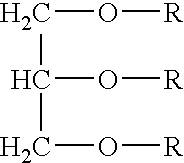Antioxidant triacylglycerols and lipid compositions
a technology of triacylglycerol and lipid composition, which is applied in the direction of fatty acid chemical modification, biocide, food preparation, etc., can solve the problems of the physical properties of functional foods, and achieve the effects of reducing oxidative stress, high unsaturation, and maintaining the health of the circulatory and nervous system
- Summary
- Abstract
- Description
- Claims
- Application Information
AI Technical Summary
Benefits of technology
Problems solved by technology
Method used
Image
Examples
example i
Interesterification
[0052] In one embodiment, a lipid composition of the present invention was made by interesterification of flaxseed oil with pyruvic acid, in a 1:5 molar ratio and catalyzed by an immobilized sn-1,3 regioselective lipase from Rhizomucor miehei. The interesterification was carried out at 50° C. for about 7 hours.
[0053] Phase separation of the reaction contents yielded a pyruvic acid rich aqueous phase which also contains the lipase and a top organic phase containing the reacted and unreacted lipids. The oil phase was purified by preparative thin-layer chromatography (TLC) on silica gel G plates using a solvent mixture of hexane, diethyl ether and acetic acid (70:30:1) as the mobile phase. As a result, the lipids were fractionated into triacylglycerols (78%), diacylglycerols (9%), monoacylglycerols (4%) and free fatty acids (9%).
[0054] The triacylglycerol fraction was scraped from the plate and eluted with water saturated diethyl ether, which was then evaporated a...
example ii
Formulation of Lipid Product into Yoghurt
[0065] In this example, a lipid composition was prepared so as to yield a pyruvic acid concentration of 7.6% w / w lipid (30 mol %). The ALA content was 40% w / w lipid (48 mol %). Three different yoghurts were used for formulation purposes: plain, soy and bumbleberry yoghurt. Lipid was stirred into the yoghurt to yield different concentrations ranging from 0 to 3%) and a study on the physical characteristics of the fortified and unfortified yoghurts was conducted. [0066] Peroxide value: 65% less than that of the parent oil. [0067] Color & Texture: Unaffected at all concentrations.
[0068] Taste and odor: Masking of these properties entirely in the bumbleberry yoghurts. In the regular and soy yoghurts, an alteration in both taste and odor of yoghurts was noticed beyond 1% lipid.
LipidTempViscosityViscosityYogurt Type(%)pH(° C.)(mPa · s / g)Change (%)Regular: No Fat0.003.98523.06100.00253.00100.00372.28100.00Regular: No Fat0.744.01523.61102.39253.4...
PUM
| Property | Measurement | Unit |
|---|---|---|
| mol % | aaaaa | aaaaa |
| total volume | aaaaa | aaaaa |
| wavelength | aaaaa | aaaaa |
Abstract
Description
Claims
Application Information
 Login to View More
Login to View More - R&D
- Intellectual Property
- Life Sciences
- Materials
- Tech Scout
- Unparalleled Data Quality
- Higher Quality Content
- 60% Fewer Hallucinations
Browse by: Latest US Patents, China's latest patents, Technical Efficacy Thesaurus, Application Domain, Technology Topic, Popular Technical Reports.
© 2025 PatSnap. All rights reserved.Legal|Privacy policy|Modern Slavery Act Transparency Statement|Sitemap|About US| Contact US: help@patsnap.com



